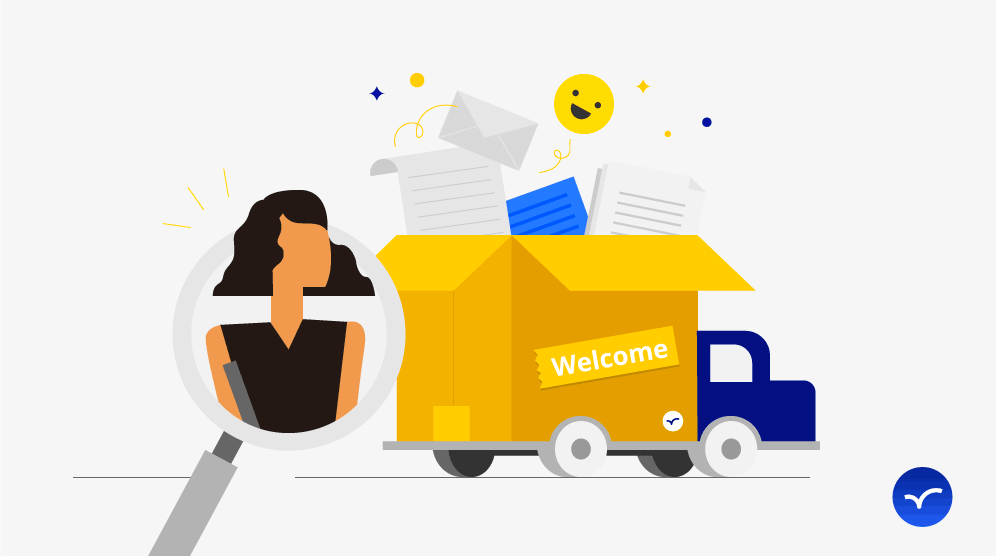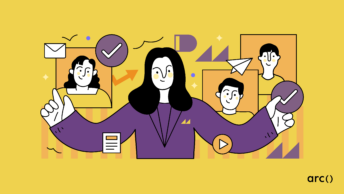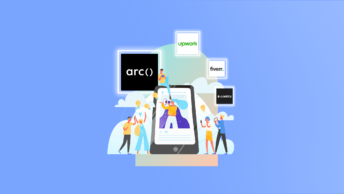Remote onboarding matters!
Consider the following:
“Here’s Slack, here’s the Notion doc, and here’s the link to our onboarding call. Oh, and there’s an outdated handbook from 2012 if you’re curious. Welcome aboard!”
Sound familiar? This kind of half-baked remote onboarding leaves your newest team member scrambling—and eyeing other opportunities. Fast-moving startups know the drill: nail your onboarding or risk losing great talent.
While we talked in general about the employee induction process in the past, this time around, we wanted to dig just that little bit deeper and share some of the pitfalls you might encounter when building a remote onboarding experience for your new hire. After all, there’s always room to improve!
Here’s why bad onboarding costs more than you think:
- 63% of remote workers feel undertrained (no, they can’t “just figure it out”).
- 60% feel lost during onboarding—and not in a cool, creative way.
- 36% find the whole thing confusing (because no one wrote it down).
And that’s not even touching on the complexities of onboarding remote team members! Let’s unpack how to make a successful remote onboarding process so your new hires can have a great first experience.
Looking for top talent fast? See how Arc can help you:
⚡️ Find developers, designers, marketers, and more
⚡️ Freelance or full-time remote + fully vetted
⚡️ Save up to 80% with global hires
Hire top talent with Arc risk-free →
Start with a Manager Onboarding Checklist
If you paid attention to that subheading, we didn’t say to start with a remote employee onboarding checklist!
Coming up with the best onboarding practices from scratch might make you want to sit down and start thinking about what your new hire will need to work through. That’s thinking about the problem backward, though.
First, you’ll need to create a checklist for yourself.
What should be on your remote onboarding checklist
HR setup
- Set up a simple Google Form (or Typeform, if you’re fancy) to grab personal details upfront.
- Share a digital contract with a clear “sign by” date (bonus: use DocuSign or HelloSign for speed).
- Coordinate with other departments to ensure the new hire is set up across all internal systems (and choose an EOR for global payroll)
- Create a data-driven review system for cultural fit, skills, project work and quality, and timeliness
- Create a welcome email, including links to the intranet (if applicable), the software required, knowledge documents (don’t forget policies), first day details (and preferably a full month plan!), and useful contact details
- Share with the team about your new remote worker, and let them know of the new team member’s start date
Work preparation
- Send out specified hardware (if part of the contract)
- Have the new hire conduct internet speed tests and test out hardware
- Add a user account to all relevant internal systems
Knowledge sharing
- Find a mentor or partner for the new hire
- Spin up a Notion page or Slack channel packed with FAQs, workflows, and culture tips. Keep it lean, keep it clear.
- Create or update company and team workflows documents
- Create a small, customized initial project with defined success metrics
- Provide all relevant information and tools (more on this later!)
Scheduling
- Schedule 1:1 chats with team members (these can be a mixture of social and work topics)
- Request attendance at meetings for the first week (minimum)
- Ensure the mentor’s schedule is relatively free to be on call and that method of getting in touch with the mentor is clear (if the mentor has certain time availability or communication preferences, make sure these are communicated, and make sure the new hire knows that asking questions is welcomed)
Read More: How to Build and Maintain a Distributed Software Engineering Team
Don’t forget a personalized onboarding schedule
Build a lightweight schedule for your new hire, including:
- A quick intro to your team’s mission, culture, and quirks.
- A welcome chat with their “onboarding buddy” (yes, it’s a thing).
- Sharing the company goals (both immediate and long-term), and how the new hire will be contributing to these
- Introducing them to the team
- A team-building activity (if it’s possible to get together physically for this, even better)
- Walkthrough of company and team workflows
- A briefing about day to day expectations when working at the organization
- A briefing on review processes, and how the new hire’s performance will be measured
Follow up after the first month
- Do a data-driven review of how the person fit into company culture, as well as their skills, project performance, and timeliness
- Complete a 1:1 meeting with the remote hire, and have an open two-way discussion about their first month (even better, make these weekly!)
- Review and refine the process for next time (including getting feedback from the new hire)
You can also try Arc, your shortcut to the world’s best remote talent:
⚡️ Access 450,000 top developers, designers, and marketers
⚡️ Vetted and ready to interview
⚡️ Freelance or full-time
Try Arc and hire top talent now →
Want Best in Class Onboarding for Remote Talent? Document It!
And we definitely don’t just mean email!
Become more data-driven, even across the onboarding process, by developing an onboarding hub for remote workers stuffed with all the information they need. This can be a Google doc, or simply a Notion page where newbies can log in securely with a set of credentials. Make it mobile-responsive for the ultimate in employee onboarding flexibility.
Furnish your onboarding doc with custom forms (which can automatically update your HR systems with their details), company videos, training documents, interactive learning modules, an onboarding schedule, their project, and links to all necessary software downloads.
If desired, collect weblogs and clickstream events to see how each hire interacts with your hub for further refinement the next time around.
Read More: To Scrum With Freelance Developers: Pros and Cons & How to Do It Right
Have a Smooth Developer Pre-Boarding Process for Onboarding New Hires
Filling in forms and doing “click, click, click” workplace training isn’t exactly most people’s favorite pastime, especially if the content is snore-worthy.
Pre-boarding isn’t just a formality—it’s your chance to hype up day one. Make it fun, make it clear, and make sure everything’s ready before they even log on.
How can you make sure your latest hire is engaged on their first day and isn’t playing catch up with pre-boarding they should’ve previously completed? Take a leaf out of Specsavers’ book.
Specsavers and Sponge developed an interesting, gamified global pre-boarding program that also makes a donation towards charitable donation, motivating hires to complete before day one. The results? Well, they speak for themselves.
- £170,000 (just over $200k USD) in global savings
- 71% of new employees voluntarily started onboarding before starting work
Have a Mentor For Each New Remote Team Memer
Don’t leave your new hire swimming in a sea of Slack messages. Pair them with a buddy who knows the ropes and speaks startup fluently.
Enlist the help of a fellow employee to walk each new hire through the onboarding process, be there to ask questions, etc. This person should ideally be their supervisor or someone senior who knows a lot about the company and processes, like at Hanno:
(We use) an onboarding ‘track’ in Asana (which contains a whole series of tasks for them to complete, exposing them to many different areas of the company) and also try to pair this up with in-person mentoring and support. That mentoring component has been really important–those first weeks of joining a remote team as a new employee can be a real challenge, so having a buddy to help you out and guide you through all the things you can’t necessarily see is really handy.
Read More: How to Be an Engineering Manager Your Company & Team Respects
Have an Induction Schedule for (At Least) Week One
Think one or two days is enough of a primer before being set loose on your major project? Let’s put it this way: would you know whether someone is partner material after just one or two dates? Highly unlikely.
A structured induction week is similar to orientation week at university or college: showing you around the campus, getting a taster of classes and groups you could join, giving you key information about culture, familiarization with facilities and tools…
At Zapier, onboarding remotely looks a lot like onboarding on-site, with a very packed and well-organized schedule for week 1.
But it’s better to have the first month planned out
If you had a read through the Zapier schedule above (and if you didn’t, go check it out now!) you’ll see that their week one schedule is packed. However, the full induction process extends out to week four and even beyond, with the capstone of onboarding flying out to meet some of the team in California.
Ted Goas from Stack Overflow details how the company went from the “thrown in the deep end” onboarding approach to a comprehensive monthly plan in advance:
We now have an onboarding process that spans a new hire’s first month, broken out by week. Everyone now knows what’s expected from a new hire after their first week, after their second, and so on. A new hire can skip ahead if they want, but expectations are clear and what should be happening at any given point. Whatever shape it takes, it helps to have an onboarding process beyond those first few days so that everyone (the new hire AND the existing team) knows what is expected each week and what to tackle next.
Ted Goas
Read More: How to Create a Software Development Workflow for Freelance Hires
Start with an Onboarding Project
New remote workers on the engineering team should generally not be unleashed on the production code from the beginning. Instead, remember that this is a trial period: you want to see how they do without potentially jeopardizing your project!
The traditional way to test out their skills is to give them a small project that is relevant to your actual project. Do you need to build out a workflow with a GUI between some tools you use? Perhaps you have a clunky piece of internal software that could use a spruce up?
You may even give them a small project that’s been completed by someone else to see how they do things differently. This mini-project should take around two to three weeks from start to finish.
Take this advice from Time Doctor, too:
“We don’t necessarily care if they succeed, but we want to see if the person is someone we enjoy working with, can handle working remotely, and we want to see how they approach the task.”
Here at Arc, our Director of Engineering expects the new hire to deploy their first production build within the first week. This means that the new team member runs through our development process from end to end, and the task isn’t too easy or too hard.
The task also ensures the new hire understands our technical structure (code structure, service architecture, etc).
The take-home? Decide on the size and type of project for your new hire that suits your team’s individual situation — but get them onto the real work as soon as possible!
Read More: How to Integrate Freelance Software Developers Into Your Current Team
Personalize Your New Hire’s Experience and Work Goals
You may have noticed that all our points so far have been about getting the most out of your new hire from a company perspective.
If you only concentrate on what you want from a person, you’re neglecting to feed their personal worth. Neglect this long enough and they’ll bounce to a less traditional company that values their personal growth and experiences.
So, how can you incorporate this?
The most critical part of our onboarding process is defining an individual Vision, Values, Methods, Obstacles, Measurements (V2MOM) document as a method to orient and align all employees as early as possible. It’s fantastic for clearly defining expectations and a path to success.
Steve at Statflo
Make the Onboarding Process Adaptive
It may or may not go without saying, but the process you’ve developed should be transformative with each hire. It’s an evolutionary product that may need tweaking after each new person in the door. Ask all newbies for feedback on how they found the process, from start to finish. This way you can tweak and improve for the next new hire!
Watch what other startups are doing to stay competitive. Stay scrappy, keep tweaking, and make onboarding part of your secret sauce.
Read More: How to Implement a Welcoming Software Developer Onboarding Process
For Developers, Ensure to Have the Dev Environment as Code
While you won’t be unleashing new staff on your codebase straight away, make sure their coding environment is standard and repeatable for new hires by creating your internal development environment as code (and updating when it changes via version control).
And More Possibilities…
Developing an onboarding program is a unique process that is never going to be the same across companies. Some more options you can consider are flying the new hire in for a week-long on-site like Help Scout does (if you have an office, that is).
Finding a remote hire who knows what they’re doing in the first place helps smooth the onboarding process considerably.
You can also try Arc, your shortcut to the world’s best remote talent:
⚡️ Access 450,000 top developers, designers, and marketers
⚡️ Vetted and ready to interview
⚡️ Freelance or full-time








